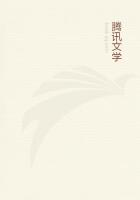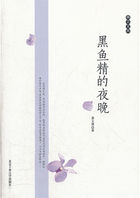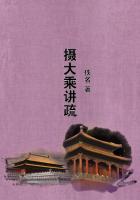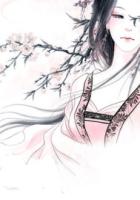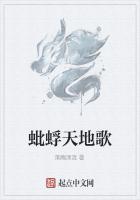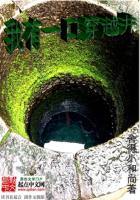The first monuments were simple masses of rock, “which the iron had not touched, ”as Moses says.Architecture began like all writing.It was first an alphabet.Men planted a stone upright, it was a letter, and each letter was a hieroglyph, and upon each hieroglyph rested a group of ideas, like the capital on the column.This is what the earliest races did everywhere, at the same moment, on the surface of the entire world.We find the“standing stones”of the Celts in Asian Siberia; in the pampas of America.
Later on, they made words; they placed stone upon stone, they coupled those syllables of granite, and attempted some combinations. The Celtic dolmen and cromlech, the Etruscan tumulus, the Hebrew galgal, are words.Some, especially the tumulus, are proper names.Sometimes even, when men had a great deal of stone, and a vast plain, they wrote a phrase.The immense pile of Karnac is a complete sentence.
At last they made books. Traditions had brought forth symbols, beneath which they disappeared like the trunk of a tree beneath its foliage; all these symbols in which humanity placed faith continued to grow, to multiply, to intersect, to become more and more complicated; the first monuments no longer sufficed to contain them, they were overflowing in every part; these monuments hardly expressed now the primitive tradition, simple like themselves, naked and prone upon the earth.The symbol felt the need of expansion in the edifice.Then architecture was developed in proportion with human thought; it became a giant with a thousand heads and a thousand arms, and fixed all this floating symbolism in an eternal, visible, palpable form.While Daedalus, who is force, measured; while Orpheus, who is intelligence, sang; —the pillar, which is a letter; the arcade, which is a syllable; the pyramid, which is a word, —all set in movement at once by a law of geometry and by a law of poetry, grouped themselves, combined, amalgamated, descended, ascended, placed themselves side by side on the soil, ranged themselves in stories in the sky, until they had written under the dictation of the general idea of an epoch, those marvellous books which were also marvellous edifices:the Pagoda of Eklinga, the Rhamseion of Egypt, the Temple of Solomon.
The generating idea, the word, was not only at the foundation of all these edifices, but also in the form.The temple of Solomon, for example, was not alone the binding of the holy book; it was the holy book itself.On each one of its concentric walls, the priests could read the word translated and manifested to the eye, and thus they followed its transformations from sanctuary to sanctuary, until they seized it in its last tabernacle, under its most concrete form, which still belonged to architecture:the arch.Thus the word was enclosed in an edifice, but its image was upon its envelope, like the human form on the coffin of a mummy.
And not only the form of edifices, but the sites selected for them, revealed the thought which they represented, according as the symbol to be expressed was graceful or grave. Greece crowned her mountains with a temple harmon-ious to the eye; India disembowelled hers, to chisel therein those monstrous subterranean pagodas, borne up by gigantic rows of granite elephants.
Thus, during the first six thousand years of the world, from the most immemorial pagoda of Hindustan, to the cathedral of Cologne, architecture was the great handwriting of the human race. And this is so true, that not only every religious symbol, but every human thought, has its page and its monument in that immense book.
All civilization begins in theocracy and ends in democracy. This law of liberty following unity is written in architecture.For, let us insist upon this point, masonry must not be thought to be powerful only in erecting the temple and in expressing the myth and sacerdotal symbolism; in inscribing in hieroglyphs upon its pages of stone the mysterious tables of the law.If it were thus, —as there comes in all human society a moment when the sacred symbol is worn out and becomes obliterated under freedom of thought, when man escapes from the priest, when the excrescence of philosophies and systems devour the face of religion, —architecture could not reproduce this new state of human thought; its leaves, so crowded on the face, would be empty on the back; its work would be mutilated; its book would he incomplete.But no.
Let us take as an example the Middle Ages, where we see more clearly because it is nearer to us.During its first period, while theocracy is organizing Europe, while the Vatican is rallying and reclassing about itself the elements of a Rome made from the Rome which lies in ruins around the Capitol, while Christianity is seeking all the stages of society amid the rubbish of anterior civilization, and rebuilding with its ruins a new hierarchic universe, the keystone to whose vault is the priest—one first hears a dull echo from that chaos, and then, little by little, one sees, arising from beneath the breath of Christianity, from beneath the hand of the barbarians, from the fragments of the dead Greek and Roman architectures, that mysterious Romanesque architecture, sister of the theocratic masonry of Egypt and of India, inalterable emblem of pure catholicism, unchangeable hieroglyph of the papal unity. All the thought of that day is written, in fact, in this sombre, Romanesque style.One feels everywhere in it authority, unity, the impenetrable, the absolute, Gregory VII.; always the priest, never the man; everywhere caste, never the people.
But the Crusades arrive. They are a great popular movement, and every great popular movement, whatever may be its cause and object, always sets free the spirit of liberty from its final precipitate.New things spring into life every day.Here opens the stormy period of the Jacqueries, Pragueries, and Leagues.Authority wavers, unity is divided.Feudalism demands to share with theocracy, while awaiting the inevitable arrival of the people, who will assume the part of the lion:Quia nominor leo.Seignory pierces through sacerdotalism; the commonality, through seignory.The face of Europe is changed.Well!the face of architecture is changed also.Like civilization, it has turned a page, and the new spirit of the time finds her ready to write at its dictation.It returns from the crusades with the pointed arch, like the nations with liberty.
Then, while Rome is undergoing gradual dismemberment, Romanesque architecture dies.The hieroglyph deserts the cathedral, and betakes itself to blazoning the donjon keep, in order to lend prestige to feudalism.The cathedral itself, that edifice formerly so dogmatic, invaded henceforth by the bourgeoisie, by the community, by liberty, escapes the priest and falls into the power of the artist.The artist builds it after his own fashion.Farewell to mystery, myth, law.Fancy and caprice, welcome.Provided the priest has his basilica and his altar, he has nothing to say.The four walls belong to the artist.The architectural book belongs no longer to the priest, to religion, to Rome; it is the property of poetry, of imagination, of the people.Hence the rapid and innumerable transformations of that architecture which owns but three centuries, so striking after the stagnant immobility of the Romanesque architecture, which owns six or seven.Nevertheless, art marches on with giant strides.Popular genius amid originality accomplish the task which the bishops formerly fulfilled.Each race writes its line upon the book, as it passes; it erases the ancient Romanesque hieroglyphs on the frontispieces of cathedrals, and at the most one only sees dogma cropping out here and there, beneath the new symbol which it has deposited.The popular drapery hardly permits the religious skeleton to be suspected.One cannot even form an idea of the liberties which the architects then take, even toward the Church. There are capitals knitted of nuns and monks, shamelessly coupled, as on the hall of chimney pieces in the Palais de Justice, in Paris.There is Noah's adventure carved to the last detail, as under the great portal of Bourges.There is a bacchanalian monk, with ass's ears and glass in hand, laughing in the face of a whole community, as on the lavatory of the Abbey of Bocherville.There exists at that epoch, for thought written in stone, a privilege exactly comparable to our present liberty of the press.It is the liberty of architecture.
This liberty goes very far. Sometimes a portal, a front, an entire church, presents a symbolical sense absolutely foreign to worship, or even hostile to the Church.In the thirteenth century, Guillaume de Paris, and Nicholas Flamel, in the fifteenth, wrote such seditious pages.Saint-Jacques de la Boucherie was a whole church of the opposition.
Thought was then free only in this manner; hence it never wrote itself out completely except on the books called edifices. Thought, under the form of edifice, could have beheld itself burned in the public square by the hands of the executioner, in its manu form, if it had been sufficiently imprudent to risk itself thus; thought, as the door of a church, would have been a spectator of the punishment of thought as a book.Having thus only this resource, masonry, in order to make its way to the light, flung itself upon it from all quarters.Hence the immense quantity of cathedrals which have covered Europe—a number so prodigious that one can hardly believe it even after having verified it.All the material forces, all the intellectual forces of society converged towards the same point:architecture.In this manner, under the pretext of building churches to God, art was developed in its magnificent proportions.
Then whoever was born a poet became an architect.Genius, scattered in the masses, repressed in every quarter under feudalism as under a testudo of brazen bucklers, finding no issue except in the direction of architecture, —gushed forth through that art, and its Iliads assumed the form of cathedrals.All other arts obeyed, and placed themselves under the discipline of architecture.They were the workmen of the great work.The architect, the poet, the master, summed up in his person the sculpture which carved his fa?ades, painting which illuminated his windows, music which set his bells to pealing, and breathed into his organs. There was nothing down to poor poetry, —properly speaking, that which persisted in vegetating in manus, —which was not forced, in order to make something of itself, to come and frame itself in the edifice in the shape of a hymn or of prose; the same part, after all, which the tragedies of AEschylus had played in the sacerdotal festivals of Greece; Genesis, in the temple of Solomon.
Thus, down to the time of Gutenberg, architecture is the principal writing, the universal writing. In that granite book, begun by the Orient, continued by Greek and Roman antiquity, the Middle Ages wrote the last page.Moreover, this phenomenon of an architecture of the people following an architecture of caste, which we have just been observing in the Middle Ages, is reproduced with every analogous movement in the human intelligence at the other great epochs of history.Thus, in order to enunciate here only summarily, a law which it would require volumes to develop:in the high Orient, the cradle of primitive times, after Hindoo architecture came Phoenician architecture, that opulent mother of Arabian architecture; in antiquity, after Egyptian architecture, of which Etruscan style and cyclopean monuments are but one variety, came Greek architecture, surcharged with the Carthaginian dome; in modern times, after Romanesque architecture came Gothic architecture.And by separating there three series into their component parts, we shall find in the three eldest sisters, Hindoo architecture, Egyptian architecture, Romanesque architecture, the same symbol; that is to say, theocracy, caste, unity, dogma, myth, God:and for the three younger sisters, Phoenician architecture, Greek architecture, Gothic architecture, whatever, nevertheless, may be the diversity of form inherent in their nature, the same signification also; that is to say, liberty, the people, man.
In the Hindu, Egyptian, or Romanesque architecture, one feels the priest, nothing but the priest, whether he calls himself Brahmin, Magian, or Pope. It is not the same in the architectures of the people.They are richer and less sacred.In the Phoenician, one feels the merchant; in the Greek, the republican; in the Gothic, the citizen.
The general characteristics of all theocratic architecture are immutability, horror of progress, the preservation of traditional lines, the consecration of the primitive types, the constant bending of all the forms of men and of nature to the incomprehensible caprices of the symbol. These are dark books, which the initiated alone understand how to decipher.Moreover, every form, every deformity even, has there a sense which renders it inviolable.Do not ask of Hindoo, Egyptian, Romanesque masonry to reform their design, or to improve their statuary.Every attempt at perfecting is an impiety to them.In these architectures it seems as though the rigidity of the dogma had spread over the stone like a sort of second petrifaction.The general characteristics of popular masonry, on the contrary, are progress, originality, opulence, perpetual movement.They are already sufficiently detached from religion to think of their beauty, to take care of it, to correct without relaxation their parure of statues or arabesques.They are of the age.They have something human, which they mingle incessantly with the divine symbol under which they still produce.Hence, edifices comprehensible to every soul, to every intelligence, to every imagination, symbolical still, but as easy to understand as nature.Between theocratic architecture and this there is the difference that lies between a sacred language and a vulgar language, between hieroglyphics and art, between Solomon and Phidias.
If the reader will sum up what we have hitherto briefly, very briefly, indicated, neglecting a thousand proofs and also a thousand objections of detail, be will be led to this:that architecture was, down to the fifteenth century, the chief register of humanity; that in that interval not a thought which is in any degree complicated made its appearance in the world, which has not been worked into an edifice; that every popular idea, and every religious law, has had its monumental records; that the human race has, in short, had no important thought which it has not written in stone.And why?Because every thought, either philosophical or religious, is interested in perpetuating itself; because the idea which has moved one generation wishes to move others also, and leave a trace.Now, what a precarious immortality is that of the manu!How much more solid, durable, unyielding, is a book of stone!In order to destroy the written word, a torch and a Turk are sufficient.To demolish the constructed word, a social revolution, a terrestrial revolution are required.The barbarians passed over the Coliseum; the deluge, perhaps, passed over the Pyramids.







